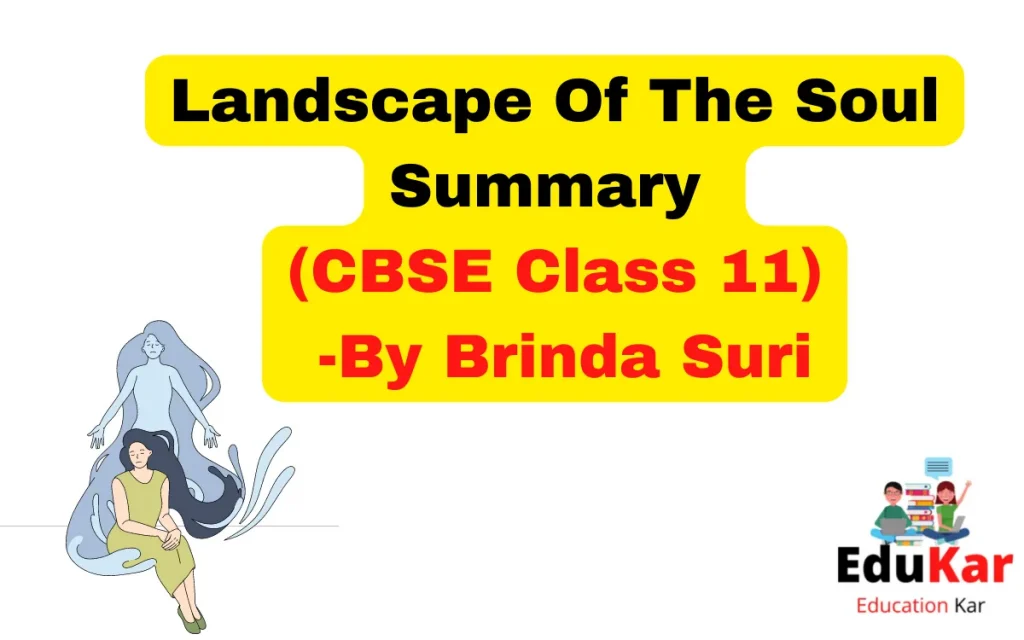
| Name | Landscape Of The Soul |
| Type | Summary |
| Class | 11 |
| Board | CBSE Board |
| Author | Brinda Suri |
Short Summary- Landscape Of The Soul
This chapter is divided into two sections, each of which uses a variety of stories to teach us about art and its history. In the section from “Landscape of the Soul: Ethics and Spirituality in Chinese Painting,” two stories are used to teach us about the craft of painting. The first one is about Wu Daozi, a well-known Chinese painter. He was engaged by Tang Emperor Xuanzong to decorate a wall of the palace in the eighth century.
Wu portrayed lovely sceneries with mountains, waterfalls, woods, clouds, and blue skies, as well as people living peacefully in a joyful atmosphere. But he also painted a spirit-filled cave at the base of a mountain. The work of the master was covered behind a screen, accessible only to the Emperor. When the artist presented his work to the emperor, he forced the emperor to look at a cave at the foot of the mountain and associate it with a real spirit. The cave’s entrance opened when the painter clapped his hands. Before the Emperor could react or move, the painter entered the cave, but the door shut behind him and the painting disappeared from the wall. The artist Wu Daozi was never again seen in this world, and there was no trace of his brush.
The author claims that the disappearance signifies knowledge of the mystical inner universe. Therefore, it claims that only masters are aware of the path within and are capable of changing into any material existence. Similar to the first narrative, the second tells of a painter who trusted in the mystical powers of art. He had such a powerful and strong faith in his art that he was scared of bringing it to life and becoming a victim of a fire-breathing dragon.
The third one is up next, and it’s about a Master Blacksmith named Quinten Metsys who develops feelings for the painter’s daughter. Even though the father did not approve of his son-in-law working in such a field, he nonetheless did so. In order to accomplish this, Quinten crept into the artist’s studio and painted a fly on his most recent panel with such skillful realism that the master tried to swat it away before realising what had happened. It resembled a real one because of its delicate realism. These two narratives show what each artistic movement aims for: in Europe, a faultless, illusionistic likeness; in Asia, the essence of inner life and soul.
The author also discusses Shanshui, which is a term for mountain water in Chinese philosophy. According to Daoism, the masculine and feminine poles of this world, Yin and Yang, are in perfect balance with one another (masculine). These two energies interact to produce the world. In Daoism, a landscape is referred to as “Shanshui”. However, it represents the Daoist conception of the world rather than a real landscape.
Finally, the second chapter in Brinda Suri’s book “Getting Inside Outsider Art” discusses the idea of “art brut.” The term “art brut” refers to work created by those who “have no right” to be artists. It’s because despite not having any official training, they have artistic talent and intelligence. She describes them as the ones who challenge conventional wisdom and think beyond the box. Their creations are regarded as “unorthodox” art. French painter Jean Dubuffet questioned the idea of “art brut” in the 1940s. The untrained visionary’s art had been of secondary significance before that. “An untrained genius was building paradise” at about the same time. She uses Nek Chand’s work at the Rock Garden in Chandigarh as an illustration of art brut.
About The Author
The writer is Brinda Suri. The arts are the chapter’s central focus. It centres on the painting medium as told through a number of different stories. We gain knowledge of Chinese painters, their creations, and the narrative that inspired them.
Conclusion
In summary, the Landscape to Soul summary teaches us that art is an endless form with a rich history that defies classification and has a life of its own.



![Two Stories About Flying Summary [CBSE Class 10] By Liam OH Hearty Two Stories About Flying Summary](https://edukar.org/wp-content/uploads/2022/10/Two-Stories-About-Flying-Summary-1024x536.webp)







![The Beggar Summary in English [Class 9-Chapter 10 ] The Beggar Summary in English](https://edukar.org/wp-content/uploads/2022/10/The-Beggar-Summary-Class-9-English-1024x536.webp)



